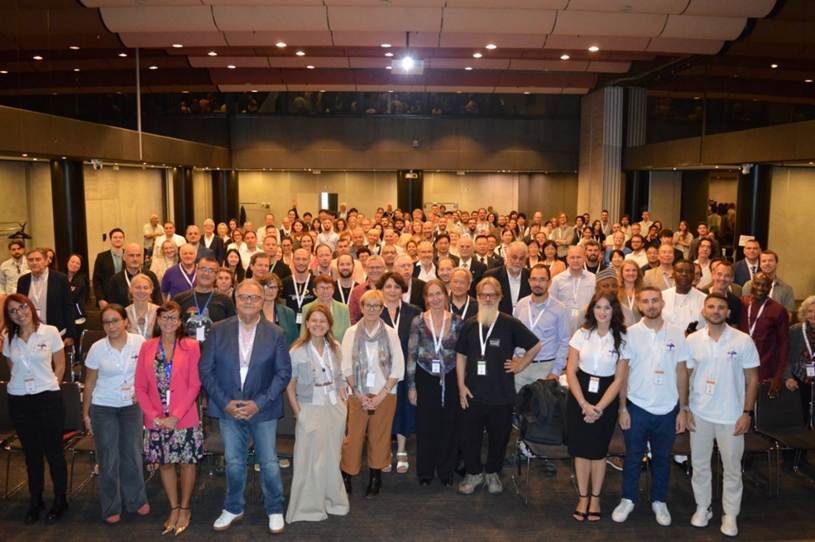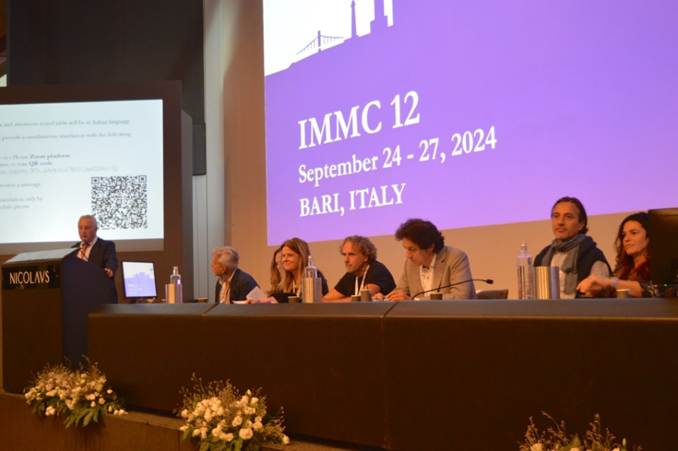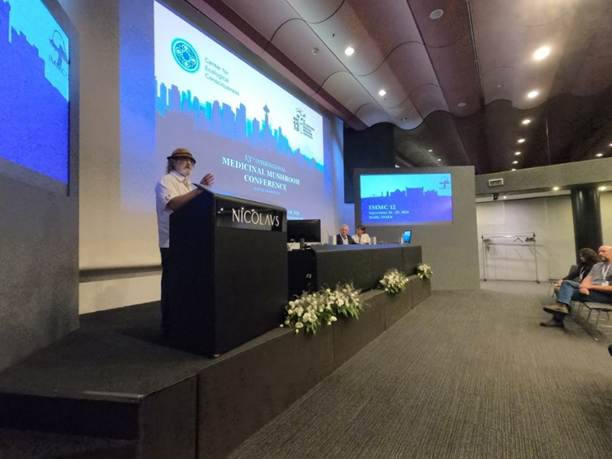The 12th International Medicinal
Mushrooms Conference (IMMC12) Held in Bari, Italy
Maria Letizia Gargano1 & Giuseppe
Venturella2*
1Department of Soil,
Plant, and Food Sciences, University of Bari Aldo Moro, Bari, Italy; 2Department of Agricultural, Food and Forest
Sciences, University of Palermo, Palermo, Italy
*Address all correspondence to: Giuseppe Venturella, Department of Agricultural, Food and Forest Sciences, University
of Palermo, Viale delle Scienze,
Bldg. 5, Palermo, Italy; giuseppe.venturella@unipa.it
In September 2024, 230 delegates from 40 different
countries (Fig. 1) gathered at The
Nicolaus Hotel Bari - HO Collection (Bari, Italy), for the 12th
International Medicinal Mushrooms Conference (IMMC12)—
the second to be held in Italy after the Palermo Conference in 2017. The theme of
the conference was “Medicinal mushrooms: the bet for the future of humanity” IMMC12
participants had the opportunity to discuss
and share scientific innovations in the medicinal mushroom sector and to become
aware of current research results.

Fig. 1. IMMC12 group
photo.
IMMC12 was organized by Prof. Maria Letizia Gargano, associate professor
of Environmental and Applied Botany at the Department of Soil, Plant, and Food Sciences,
University of Bari Aldo Moro, Bari, Italy and by Prof. Giuseppe Venturella as President
of the Italian Society of Medicinal Mushrooms (SIFM) (Fig. 2).

Fig. 2. IMMC12 opening
ceremony: from left to right: Prof. G. Venturella, Prof. F. Gentile,
and Prof. M.L. Gargano
IMMC12 was sponsored by National Biodiversity Future Center (NBFC, LAND, SPOKE 3), National
Center for Technology in Agriculture (AGRITECH), Italian Society of Medicinal Mushrooms
(SIFM), Italian Botanical Society, Journal of Fungi (MDPI), pro Herbarium Mediterraneum
International Foundation, K??p? Biotech, Alkaest, Mycolife Roma, Mycolife, Hifas
da Terra, Bona Furtuna, Italian Society of Formulators in Nutraceuticals (SIFNUT),
Associazione Luca Coscioni, Italian Academy of Medical Residents (AIMS, Bari), Azienda
Agricola Castelluccio, Natural I, MIRRI Italian Research Infrastructure for Sustainable
Bioscience and Bioeconomy, Jangsu Alphay Biological Technology Co. Ltd, DXN Malaysia,
Tyroler Glückspilze, Mycoverse, Funghi Energia e Salute, and Planta.
Attendees
presented 4 keynote speeches and 94 oral presentations in 6 symposia and a round
table, as well as 32 e-posters, during IMMC12.
On September 24, 2024,
the keynote speeches
were presented by A. Adili (Canada), “Psychedelic mushrooms as medicine: challenges
and opportunities”; T. Pálení?ek (Czech Republic), “The phenomenology of psilocybin′s
experience mediates subsequent persistent psychological effects independently of
sex, previous experience or setting”; L. Nagy (Hungary), “Basidiomycete fruiting
body development: an exciting morphogenetic process and source of bioactive compounds”
and M. Berovi? (Slovenia), “Presence and The Future of Medicinal Mushroom Process
Engineering”.
Two parallel sessions were held in the afternoon: “Diversity, evolution
and morphogenesis in medicinal mushrooms” and “Medicinal mushrooms culture collections,
cultivation technology and circular economy in rural and marginal areas”.
In the first session, chaired by G. Zervakis (Greece), 5 oral presentation
were offered by Z.J. Bair (USA), “Mining 100 Agarikon genomes: an ongoing optimization
of chemical constituents and bioefficacy”, K. Kütt (Estonia), “Distribution of Inonotus
obliquus, abundance of conks and peculiarities of basidiospore dispersal in Estonia”,
M. Zotti (Italy), “On the ecological role of medicinal mushroom Marasmius oreades:
a study case of fairy rings in the gardens of the Royal Palace of Caserta”, D. Lewinsohn
(Israel), “The epidemiology of wild mushroom poisoning in Israel”, and A. Daba (Egypt/USA),
“Remembering Tom Volk: A mycological Maestro in our hearts and minds”.
Fig. 3. Keynote speakers:
a) A. Adili (Canada), b) T. Pálení?ek (Czech Republic),
c) L. Nagy (Hungary),
and d) M. Berovi? (Slovenia).
In the other parallel session, chaired by A.F. van Peer (The Netehrlands)
and C. Jaramillo López (Colombia), 15 oral presentation were offered. The “Effects
of A. bisporus on the immune system, use of collections and can we
improve by breeding?” was the topic of the oral presentation of A.F. van Peer (The
Netehrlands) followed by the C. Jaramillo López (Colombia) who presented an oral
communication entitled “Advances in the biodegradability measurement of a hybrid
material, product of the transformation of plastic and organic waste using macromycetes”.
Other oral presentations were offered by M.
Rollini (Italy), “Reclassification and biotechnological potential of mushrooms strains
belonging to the collection of the Department of Food, Environmental and Nutritional
Sciences (DeFENS) - University of Milan (Italy)”, D. Ferrero (Italy), “Fungi’s Midas
touch: production of medicinal mushroom mycoprotein using agroindustrial by-products”,
A. Turk (Korea), “Boosting cordycepin production in Cordyceps militaris
via the influence of edible insects and medicinal plants”, J. Carrasco (Spain),
“Micosylvicultural actions towards the conservation and sustainable cultivation
of unique species (MicoAction)”, Anthea Desiderio (Italy), “Bio-recycling hazelnut
shells to enrich Lentinus tigrinus with bioactive components”, I.
Pereman (Israel), “Controlled cultivation of the medicinal mushroom Hericium
erinaceus for the enrichment and extraction of functional health promoting metabolites,
focusing on ergothioneine content, anti-oxidative potential and bioactivity in neuronal
cells”, J. Kwon (USA), “Breeding and selection for high-temperature tolerance in
Pleurotus ostreatus”, N. Holt (USA), “A novel high-temperature tolerant Pleurotus
sp.: domestication, mating behaviour and interspecies compatibility”, G. Koutotsios
(Greece), “Impact of locally available lignocellulosic residues on the cultivation
parameters and nutritional composition of the tropical milky white mushroom Calocybe
indica”, G. Balenzano (Italy), “Microwave-assisted extraction of Pleurotus
mushrooms cultivated on wine pomace and antioxydant activity evaluation”, M.
Fang (China), “Transcriptome combined with enzyme activity analysis unveiled the
key genes and pattern of lignocellulose degradation under the cultivation by corncob
in Auricularia heimuer”, M. Spagnuolo (Italy), “Innovative multifunctional
production system in marginal areas”, and G. Venturella (Italy), “Ex situ conservation,
enhancement and sustainable use of Pleurotus nebrodensis, a rare species,
endemic to Sicily (southern Italy)”.
At the end of the sessions all participants were invited to take
part in the Welcome Reception at the Cassiopea Hall of the Nicolaus Hotel. The organization
offered a folk show at the opening, and all participants were able to dance the
“Pizzica,” a popular Italian folk dance, originally from the Salento peninsula in
Apulia and later spreading throughout the rest of Apulia and the regions of Calabria
and eastern Basilicata.
On Wednesday 25 September 2024, a session entitled “Biochemistry,
biotechnology and pharmacology of medicinal mushrooms” and chaired by Marin Berovi?
(Slovenia) and ángel Trigos (Mexico) took place in the venue of the Conference.
In the morning sessiona plenary lecture was offered by U. Lindequist (Germany) who
performed with a lecture by the title “Medicinal mushrooms as multicomponent mixtures
(MOCS) - Demonstrated with the example Lentinula edodes”. Other three members
of the Scientific Committee offered lectures in this session, i.e. B. Jakopovic
(Croatia), “Impact of medicinal mushroom extracts on ribosomal biogenesis, translation,
and metabolic pathways in colorectal cancer: a proteomic study”, A. Trigos (Mexico),
“Ergosterol, a versatile metabolite of mushrooms”, and A. Daba (Egypt/USA), Medicinal
marvels of mushrooms: unlocking their potential for health and wellness”. An additional
6 oral communications completed the morning program, J. Feng (China), “Unveiling
environmental influence on high molecular weight polysaccharides in Ganoderma
lucidum submerged fermentation for industry”, J. Zhang (China), “Study on active
compounds of protecting nerve cells in Ganoderma lucidum based on spectrum-effect
relationship method”, E. ?apelja (Serbia), “Neuroprotective activity of polyamines
and phenolic compounds derived from three Fomes fomentarius strains in the
Balkan Region (Serbia, Croatia, Bosnia and Herzegovina)”, S. Hysek (Austria), “Mycelium
of medicinal mushrooms for production of mycelium-based bio-composites and its physical
and mechanical properties”, V. Ferraro (Italy), “Hypoglycemic properties of Leccinum
scabrum - An in vitro study on α-glucosidase and α-amylase inhibition activity”,
and C.-I. Jen (Taiwan), “Physicochemical characteristics and anti-breast cancer
properties of medium molecular weight sulfated polysaccharides from Laetiporus
sulphureus”.
The session continued in the afternoon under the coordination of
A. Daba (Egypt/USA) and B. Jakopovic (Croatia). 8 oral communication were offered
by F. Medri (Italy), “Chemical and functional characterization of Leccinum scabrum
and Leccinum versipelle”, V. ?olaja (Serbia), “Mycochemical profile and
antioxidant activity of two cultivated Pleurotus species: P. ostreatus
(Jacq.) P. Kumm. 1871 and P. eryngii (DC.) Quél. 1872”, F. Polito
(Italy), “Composition and antimicrobial activity of hydroalcoholic extracts of Pleurotus
eryngii var. ferulae and P. eryngii var. elaeoselini”,
M. Karaman (Serbia), “Potential of submerged exo - and intra-polysaccharides from
two Schizophyllum commune Fr. 1815 strains in biopriming of pea (Pisum
sativum L.) seed”, S. H. Kim (South Korea), “Phamacological activities and standard
compounds of Cordyceps pruinosa mycelial extracts”, O. Isikhuemhen (USA/Nigeria),
“Advances in the use of medicinal mushrooms in animal production”, O. Seniuk (Ukraine),
“Means from Fomes fomentarius for adding to the feed of domestic animals
in order to improve the quality of milk and meat products”, and E. Zapora (Poland),
“Pleurotus ostreatus as a new antimicrobial agent against bovine mastitis”.
On Thursday 26 September 2024, the Symposium, “Medicinal mushrooms
in human studies: from healthy aging to different diseases” chaired by P. Rossi
(Italy) and L. Kalitukha (Germany) began with a plenary lecture by C. Kessler (Germany)
entitled “Clinical experiences from the use of medicinal mushrooms in outpatient
hospital settings in Germany”. L. . Kalitukha (Germany) offered a oral presentation
by the title “Benefits of Fomes fomentarius fibres (Good Feeling Power?)
in the treatment of Addison's disease. Case study” followed by C. Fernandez de Ana
Portela (Spain), “Nanoemulsified fungal compounds emerge as natural immunoadjuvants
for cancer prevention and treatment in ongoing clinical trials”, N. Kurochko (Ukraine)
“Chitin-glucan-melanin complex from Fomes fomentarius as a means to stop
bleeding and treat lacerations and burns in combat conditions”, F. Brandalise (Italy),
“Electrophysiological Insights into Hericium erinaceus: Unveiling its Neuroprotective
Potential”, S. Masaphy (Israel), “Mushroom versus rare diseases: activity against
the Leishmania parasite”, V. Parisi (Italy), “Pisolithus arhizus: a bio-factory
of terpenoids and pigments with health-promoting activity”, M. Karaman (Serbia),
Ganoderma pfeifferi Bres. 1889 and G. resinaceum Boud. 1889
as potential therapeutic agents: A comparative study on antioxidant, antiproliferative
and lipid-lowering properties in alloxaninduced diabetic rats”, I. Hininger-Favier
(France), “Extracts from King Oyster mushrooms (Pleurotus eryngii), and their
major bioactive compounds, reduce inflammatory stress signals in HAPI microglia
cells”, E. Eno-Edobor (Nigeria), “Administration of Coriolus mrl resulted
in a significant reduction in PSA levels among prostate cancer patients”, J. Zhang
(Japan), “Biological role of ricin B-type lectins from the entomopathogenic fungi,
Cordyceps militaris”, Y. Park (Korea), “The improved effect of bone health
in animal models of osteoporosis administered ethanolic extracts of Wolfiporia
hoelen”, N. Watanabe (Japan), “Genome and transcriptomic analysis of biologically
active angel-wing mushroom Pleurocybella porrigens that cause acute encephalopathy”,
Y. Yang (China), “Function evaluation and mechanism study of Sanghuangporus vaninii
in inhibiting cervical cancer and lowering uric acid”, and C. Fields (USA), “Acute
effects of naturally occurring nordic Lions Mane extracts on cognitive performance”.
In the same day a parallel session entitled “Medicinal mushrooms
as a source of novel functional food and health benefits” was chaired by L. Barros
(Portugal) and A. Colletti (Italy). 17 oral communication were included in this
session perfomed by the following authors: M. Pellizzato (Italy), “Full spectrum
mycoproducts explained”, A. Colletti (Italy), “Safety and efficacy of medicinal
mushroom supplements: is a "significant history of consumption” enough”, V.
Citi (Italy), “Medicinal mushrooms: not only β-glucans for clinical practice”, S.
Badalyan (Armenia), “Recent Advances in Biotechnological and Biomedical Research
of Macrofungi”, Y. Liu (China), “Degradation of β-D-glucan from Ganoderma lucidum
to produce oligosaccharides and the separation, structural and immunoregulatory
property investigation”, D. Casulli (Italy), “Completeness of Spagyric multiextraction
from medicinal mushrooms and their relative s structures of crystallizations”, M.
K. Lee (Korea), “Production of new bioactive metabolites from Hericium erinaceus
by the regulation of cultivation conditions”, J. Daoust (USA), “Hericium
erinaceus supplementation as a prebiotic fibre impacting microbiome composition
d e and neuroactive targeted metabolomics”, I. Sofreni? (Serbia), “Application of
design of experiment and multivariate analysis in the process of Ganoderma lucidum
basidiocarps extraction”, B. An?elkovi? (Serbia), “Application of FTIR spectroscopy
in monitoring of Fomitopsis betulina fruiting bodies chemical composition”,
L. Goppa (Italy), “Integrative Omics analysis of Hericium erinaceus: comparative
insights from proteomics and NMR metabolomics”, P. García-Ponsoda (Spain), “Extraction
of antioxidant and anti-inflammatory fractions from Sparassis crispa using
dpressurized fluids”, W. Goss (USA), “Industrial cultivation of medicinal mushrooms:
unlocking functional food potential”, K. Kiss (Italy), “Mycolife liquid extracts,
the new generation of medicinal mushroom preparations. Innovative know-how procedure
and what is behind it”, E. Pereira (Portugal), “Mushroom bio-residues as a source
of dietary fibre”, O. Seniuk (Ukraine), “Biopreparation Mikosan from F. fomentarius
for plant protection” and, R. Guarcello (Italy), “Implementation of the MIRRI-SAAF
catalogue of culture collections: an example of data v management and resources
sharing”.
In the afternoon a visit to the city of Altamura (Bari) was organized
for all IMMC12 participants. The participants made atour of Altamura's main landmark,
i.e. the Romanesque cathedral, begun in 1232 by Federico II. Also organized was
a tasting of Altamura bread, baked in traditional wood and stone ovens, and known
for its fragrance, flavor and aroma.
Following this, participants took part in a social dinner at the
The Relais "I Luoghi di Pitti", built in the 16th century as a rural home,
is a wonder offered by the ancient city of Altamura (province of Bari, Puglia),
set in one of the most majestic structures of Italy's first Rural Park.
On Friday 26 September 2024, a session entitled “Therapeutic potential
of psychedelic mushrooms”, chaired by T. Re (Italy) and O.S. Isikhuemhen (USA),
featured the expected participation of Paul Stamets (USA) who offered a plenary
lecture titled “Psilocybin mushrooms: history, use and identification”. It was followed
by the lectures of D. Zullino (Italy), “Psychedelic-assisted psychotherapy - How
to catalyze the mechanisms of psychotherapeutic action”, W. Goss (USA), “Ethnomycology
and the therapeutic potential of psychedelic mushrooms: Policy and advocacy perspectives”,
T. Re (Italy), “End of life: a new training approach”, A. Metastasio (Italy), “The
use of phenomenology to understand the psychedelic experience induced by psilocybin.
New potential applications in research and clinical practice”, F. Bosco (Italy),
“Neurophenomenology in Tibetan mediation and in psychedelics”, A. Chiolerio (Italy),
“Correlation and complexity of fungal electrome”, L. Pawlik (Austria), “Heavenly
prospects: Psilocybin-induced death and god encounters compared”. The morning program
was complemented by two oral communications with remote connection to Canada by
E.C. Lewis (Canada), “Exploring the therapeutic potential of psilocybin in neurology”
and H. Farzin (Canada), “De novo implementation of publicly-funded Psilocybin-Assisted
Therapy for cancer patients in a palliative care outpatient practice: A Montreal
story”.
In the afternoon a Round Table by the title “Psychedelics between
the right to science and national laws” was co-organized with “Associazione Luca
Coscioni”, association for the freedom of scientific research founded on 2002, by
Luca Coscioni, who had amyotrophic lateral sclerosis and was a member of the Italian
Radical Party who promoted the campaign for the freedom of scientific research on
embryonic stem cells. The Round Table was attended by P. Cipriano (Italy), “Psilocybin
fungi: bridge between life and death”, G. Perrone (Italy), “The right to science
and substances under international control”, M. D’Alonzo (Italy), “The clinical
experiences that do not exist”, C. Moretti (Italy), “Compassionate therapies at
the end of life”, M. Barocchi (Italy), “MAPS in Italy – First Italian conference
on psychedelics” , and A. Faggioli (Italy), “Great treatment with psilocybin and
Ayahuasca: preliminary results”.
The conclusions were entrusted to Marco Cappato (Italy), an Italian
nonviolent activist for fundamental rights and liberties and politician.

Fig. 4. G. Venturella
introduce the round table with the participation of Marco Cappato.
The 32 e-posters provides immediate visualization of content and allows participants the opportunity to download the posters to a mobile
device, thereby contributing to the environment in terms of reducing paper use.
During the closing
ceremony, P. Stamets (USA) submitted the candidacy of Seattle
(USA) as the venue for the next IMMC13. Then M. L. Gargano and G. Venturella declared
IMMC12 closed.

Fig. 5: P. Stamets, the organizer of IMMC13 in Seattle, USA.
Prize
money, offered by the sponsor “Funghi Energia e Salute”, was awarded to 3 young participants whose
oral presentations were guided by highly sci entific
content.
C. I. Jen (Taiwan) received a prize of euro 1000,00 for
her oral presentation titled “Physicochemical characteristics
and anti-breast cancer properties of medium molecular weight sulfated polysaccharides
from Laetiporus sulphureus”, I. Sofreni? (Serbia), received
a prize of euro 500,00 for her oral presentation titled “Application of design of experiment and multivariate
analysis in the process of Ganoderma lucidum basidiocarps extraction”, and
A. Desiderio (Italy, ), received a prize of euro 500,00 for her oral presentation titled “Bio-recycling hazelnut
shells to enrich Lentinus tigrinus with bioactive components”.
In the end, the Italian Medicinal Mushroom
Society (SIFM) had the pleasure and honor to welcome as an Honorary Member Paul
Stamets, and award him
a plate for
his important and valuable cultural activitiesand as a staunch supporter of mycotherapy.